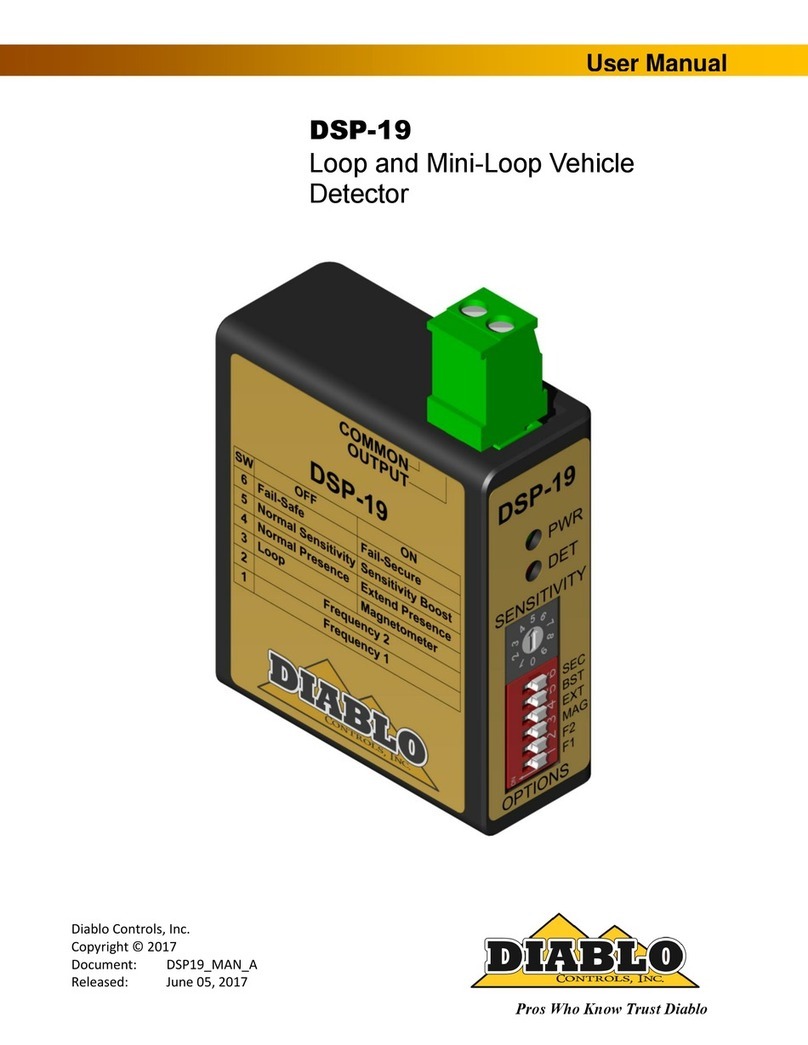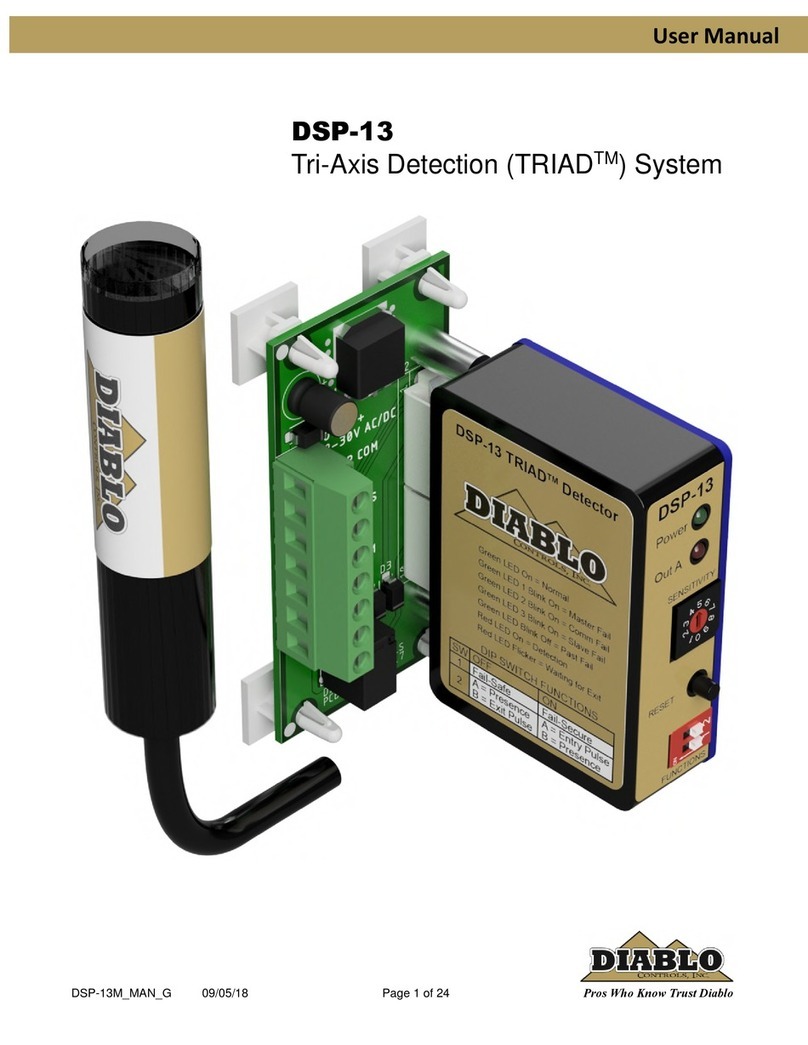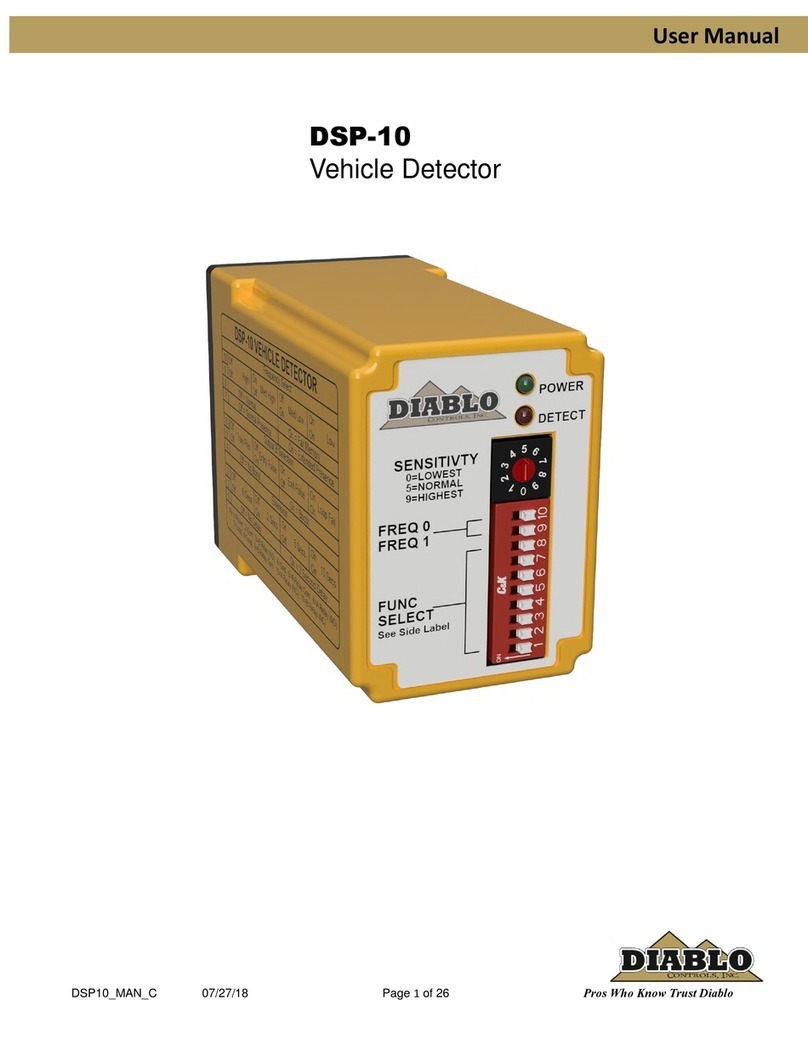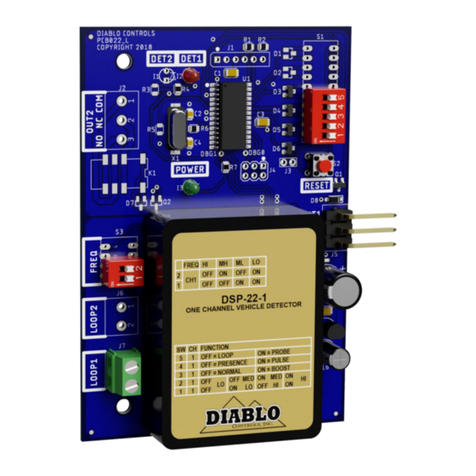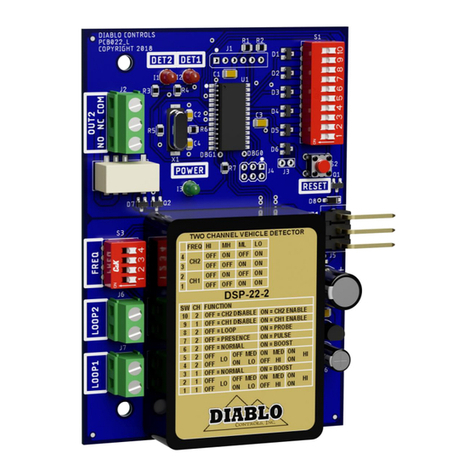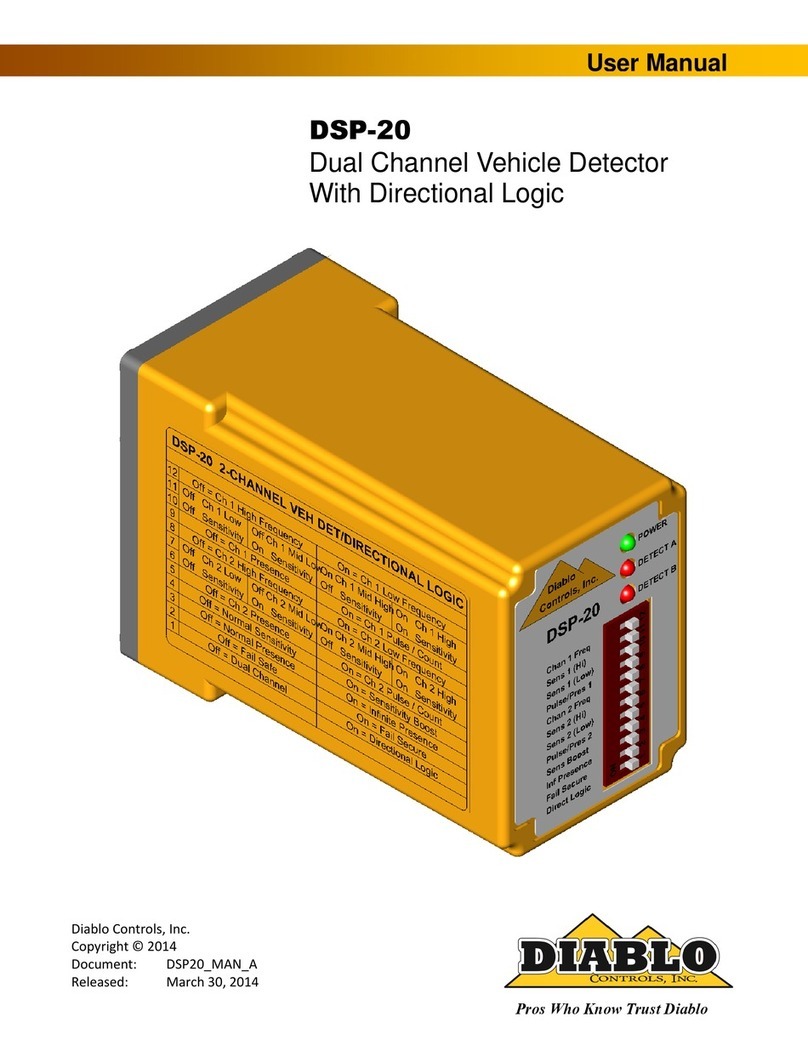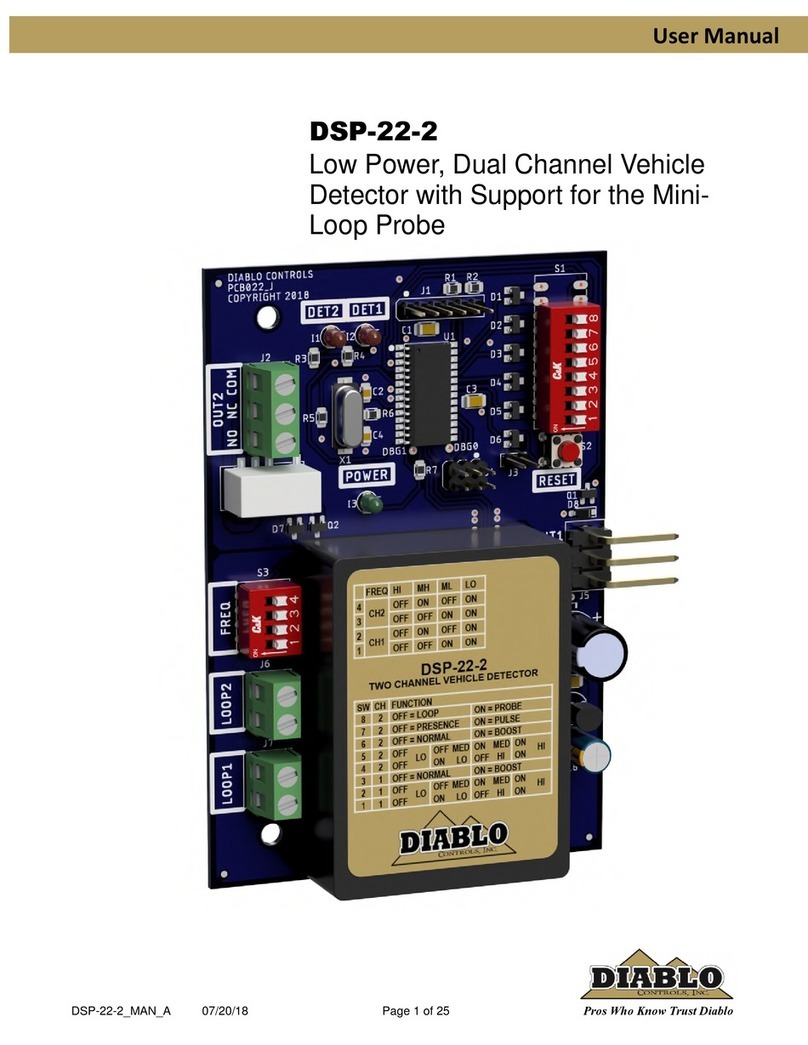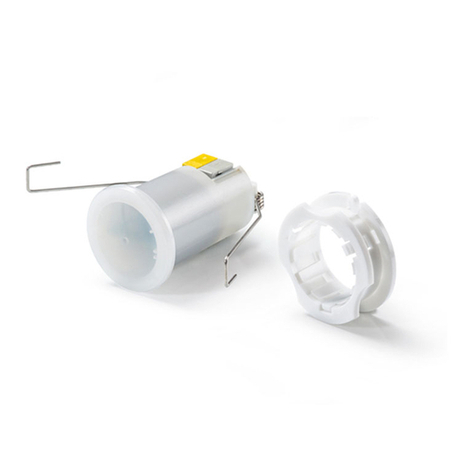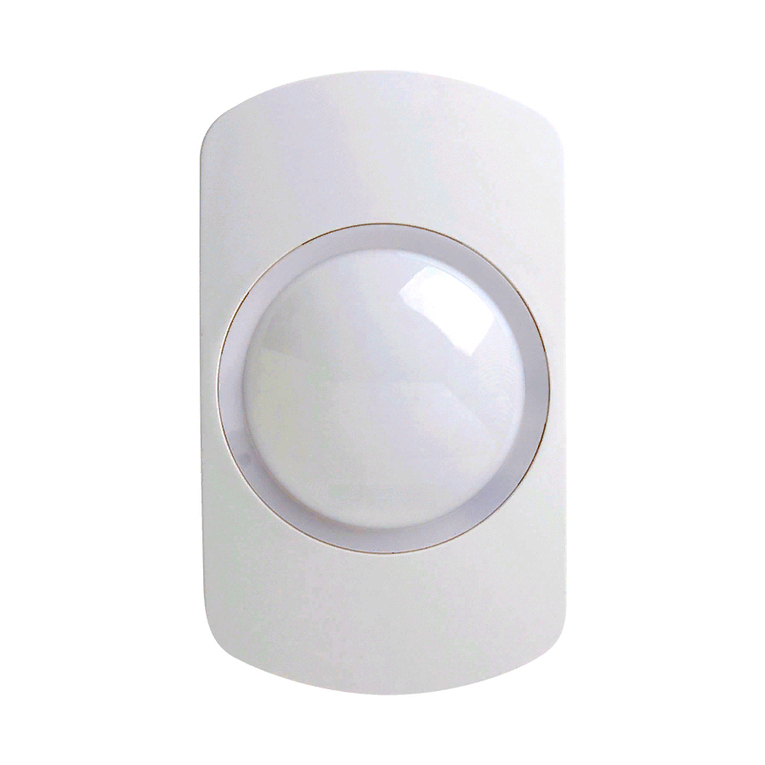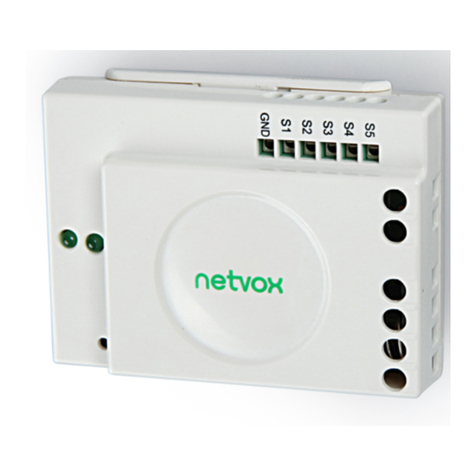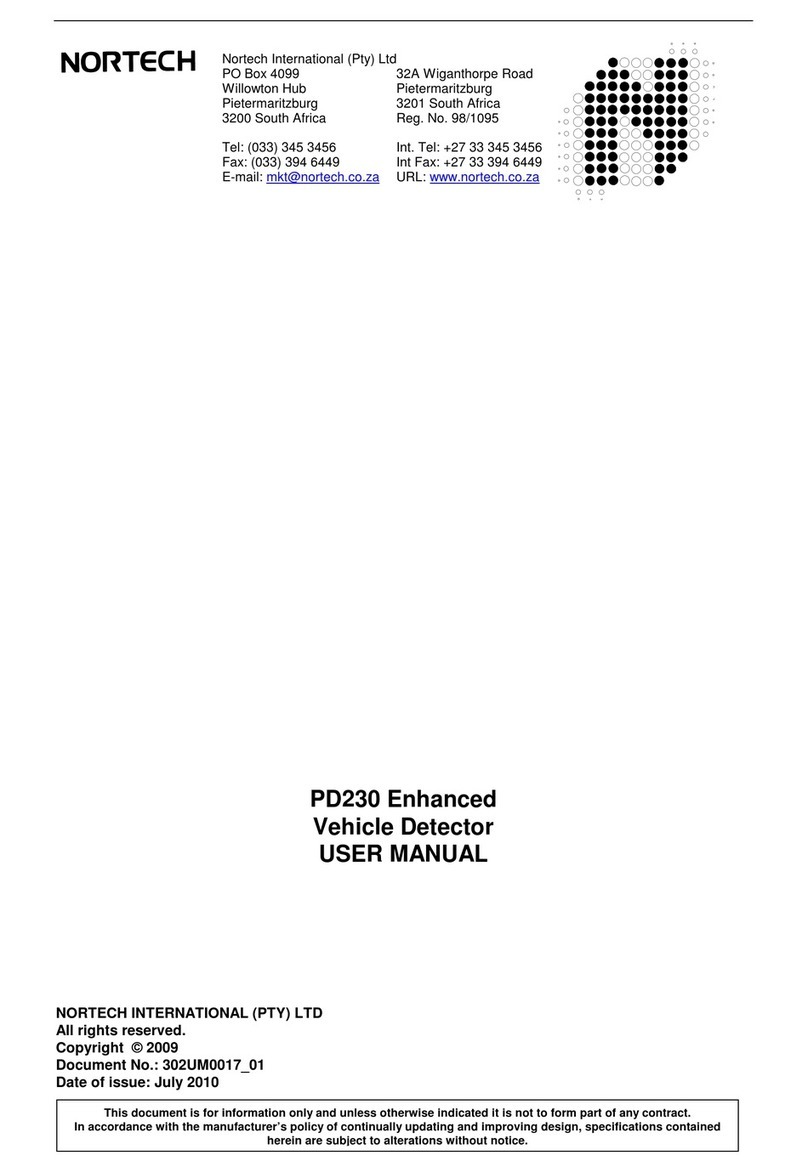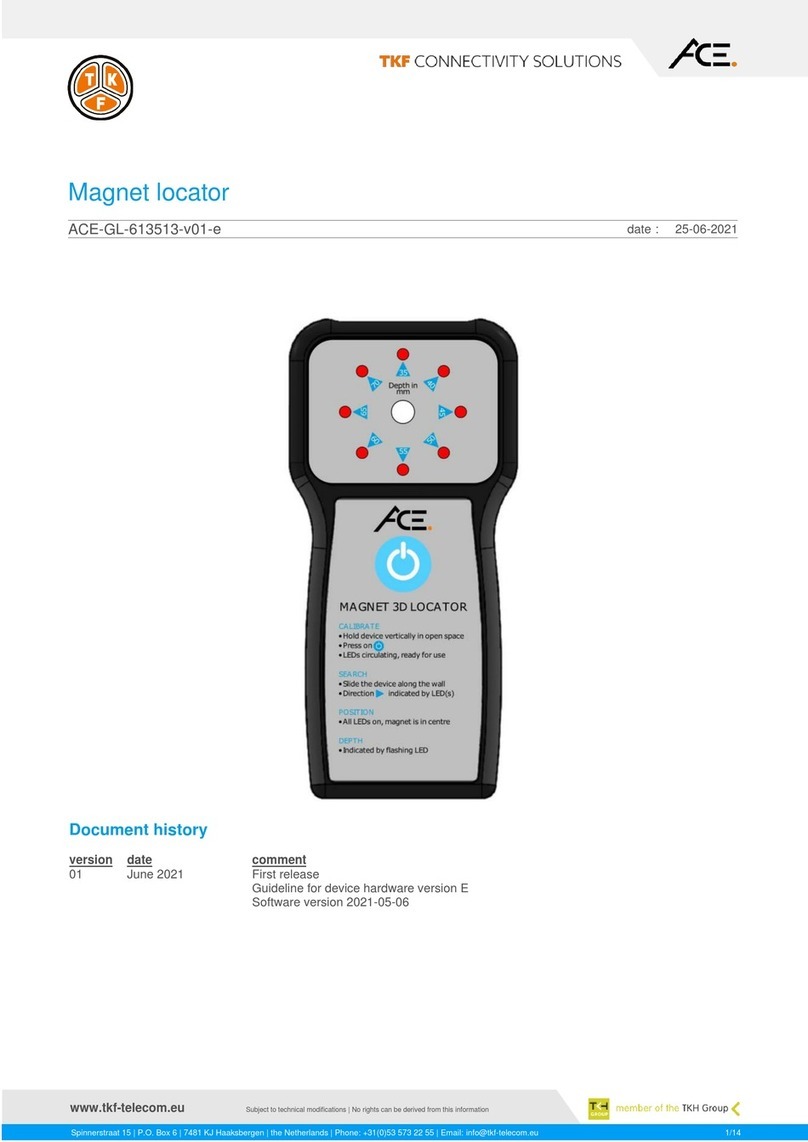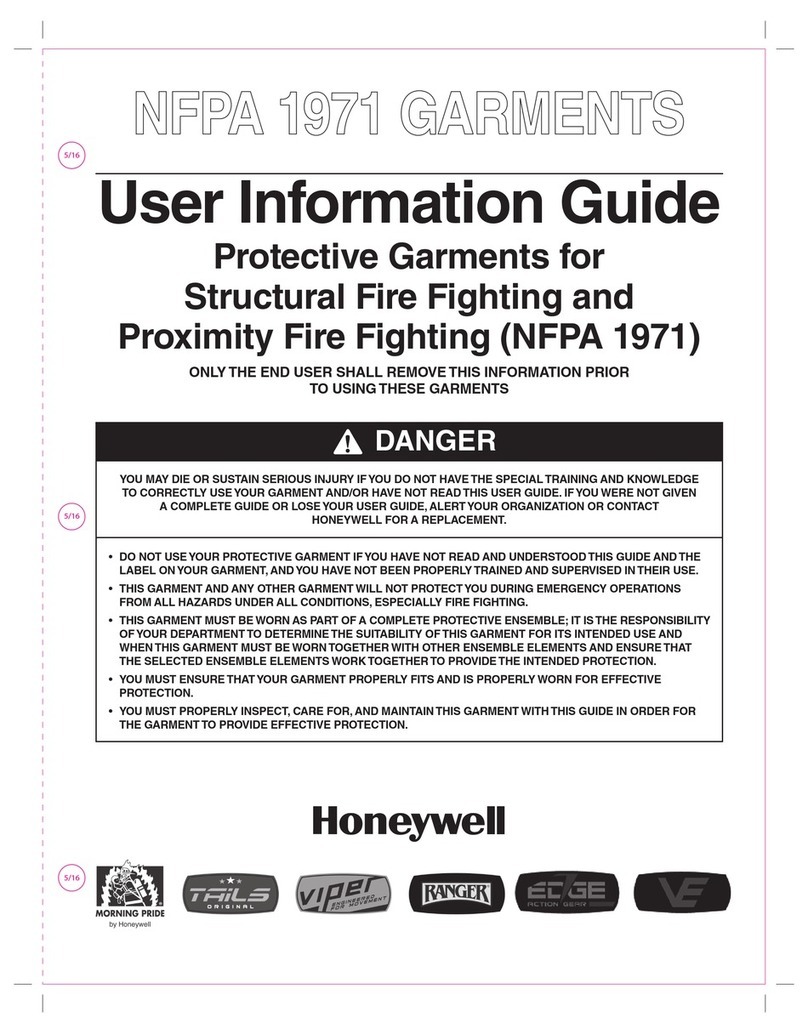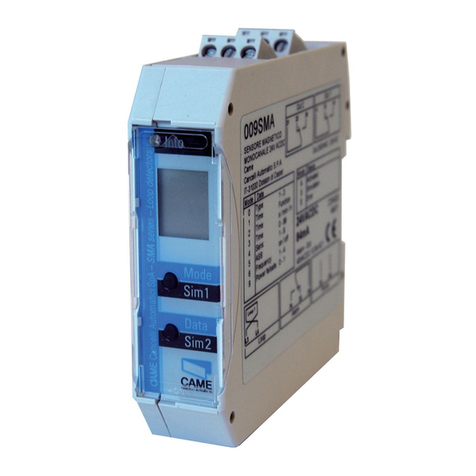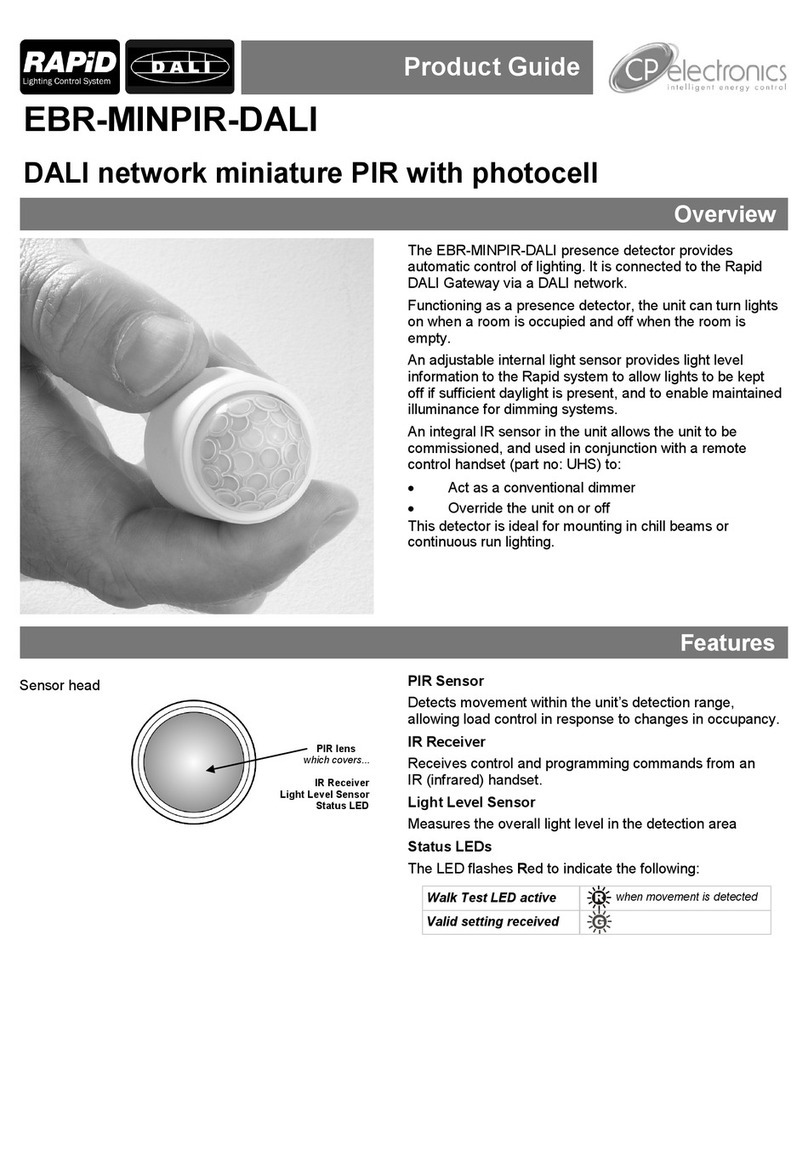Diablo DSP-20 User manual

DSP20_MAN_C 11/28/18 Page 1 of 24 Pros Who Know Trust Diablo
User Manual
DSP-20
Dual Channel Vehicle Detector
With Directional Logic

DSP-20 User Manual Page 2 of 24 DSP20_MAN_C
1. Contents
2. Table of Figures ..................................................................................................................................................3
3. Introduction........................................................................................................................................................4
4. Technical Data ....................................................................................................................................................5
Functional Data.......................................................................................................................................................5
Electrical Data.........................................................................................................................................................5
Environmental Data................................................................................................................................................5
Mechanical Data.....................................................................................................................................................6
5. Features and Functions ......................................................................................................................................7
Operating Modes....................................................................................................................................................7
Presence Detection.................................................................................................................................................8
Pulse Detection.......................................................................................................................................................8
Sensitivity................................................................................................................................................................8
Sensitivity Boost .....................................................................................................................................................8
Fail-Safe vs Fail-Secure ...........................................................................................................................................8
Fail-Safe ..................................................................................................................................................................9
Fail-Secure ..............................................................................................................................................................9
Detector Reset........................................................................................................................................................9
Channel Reset.........................................................................................................................................................9
Indicators..............................................................................................................................................................10
6. Installation........................................................................................................................................................13
Detector Installation.............................................................................................................................................13
Loop Installation ...................................................................................................................................................13
7. Configuration....................................................................................................................................................17
DIP Switches .........................................................................................................................................................17
Channel 1 Frequency (Switch 12).................................................................................................................... 17
Channel 1 Sensitivity (Switches 10 & 11) ........................................................................................................ 17
Channel 1 Pulse / Presence (Switch 9) ............................................................................................................ 17
Channel 2 Frequency (Switch 8)...................................................................................................................... 17
Channel 2 Sensitivity (Switches 6 & 7) ............................................................................................................ 18
Channel 2 Pulse / Presence (Switch 5) ............................................................................................................ 18
Sensitivity Boost (Switch 4) ............................................................................................................................. 18
Extended Presence (Switch 3) ......................................................................................................................... 18
Fail Type (Switch 2).......................................................................................................................................... 18
Directional Logic (Switch 1) ............................................................................................................................. 19
Wiring ...................................................................................................................................................................19
8. Troubleshooting ...............................................................................................................................................21
No Power LED .......................................................................................................................................................21
Flashing Power LED...............................................................................................................................................21
A Channel LED Flashes Slowly (1 Hz) ....................................................................................................................21
A Channel LED Flashes Quickly (5 Hz)...................................................................................................................22
A Channel LED Shows Two Quick Flashes Once Every Two Seconds ...................................................................22
A Channel LED Intermittently Comes On / Stays On Without a Vehicle Present.................................................22
A Channel LED Will Not Come On With a Vehicle Present...................................................................................24

DSP-20 User Manual Page 3 of 24 DSP20_MAN_C
2. Table of Figures
Figure 1: Front and Rear Views ..................................................................................................................................4
Figure 2: Physical Dimensions ....................................................................................................................................6
Figure 3: Presence and Pulse Operation in Normal Mode .........................................................................................7
Figure 4: Presence and Pulse Operation in Directional Logic.....................................................................................7
Figure 5: Power LED Indications .............................................................................................................................. 10
Figure 6: Normal Detect Red LED Indications ......................................................................................................... 11
Figure 7: Directional Logic Detect LED Indications.................................................................................................. 12
Figure 8: Loop Installation ....................................................................................................................................... 15
Figure 9: DIP Switches ............................................................................................................................................. 17

DSP-20 User Manual Page 4 of 24 DSP20_MAN_C
3. Introduction
The DSP-20 is intended to be a general purpose two-channel vehicle detector designed for the parking and access
control industries. The small package is powered by a high-performance 8-bit microcontroller that does not skimp
on performance.
The DSP-20 can operate as two independent channels or in a directional logic mode that allows the detector to
activate an output based on the vehicle’s direction of travel.
The DSP-20 is a dual-channel detector that uses advanced channel scanning technology to provide superior noise
tolerance. The scanning technology allows for placement of loops closer together (even overlapping) than ever
possible with single channel detectors. The DSP-20 continually monitors the loop circuit looking for conditions
that would signify a fault in the loop circuit and displays the type of fault identified. This quickly helps identify
open or shorted loops. Fault memory alerts the user to past faults that have automatically been recovered.
Diablo Controls’ unique flicker display helps ensure correct operation of a channel when it is operating in the pulse
mode. The channel’s detect LED will turn on while the pulse is being output then display the flicker mode while
the channel is still detecting the vehicle. This allows easy identification of a locked up channel operating in the
pulse mode.
The detector uses an 11-pin relay socket for connections and comes in three possible output versions. The
detector can be supplied with relays using either the normally open (DSP-20-NO) or the normally closed (DSP-20-
NC) contacts. There is also a solid state output version (DSP-20-SS) using an optically isolated open collector
output.
Figure 1: Front and Rear Views

DSP-20 User Manual Page 5 of 24 DSP20_MAN_C
4. Technical Data
Functional Data
Sensitivity: Four sensitivities selectable for presence or pulse modes of operation.
Low 0.50% ΔL/L
Medium Low 0.10% ΔL/L
Medium High 0.05% ΔL/L
High 0.02% ΔL/L
Frequency Settings: There are two settings per channel. The actual loop frequency is dependent on
loop circuit inductance. The detector uses a channel scanning technology to
minimize channel to channel interference.
Pulse Output: 150 millisecond on period followed by a 150 millisecond off period before the
next pulse can begin.
Response Time: 150 milliseconds
Vehicle Hold Time: Normal Presence - Approximately 1 hour for a vehicle detection of 1% ΔL/L.
Extended Presence - Approximately 18 hours for a vehicle detection of 1% ΔL/L.
Electrical Data
Loop Inductance: 20 µH to 1500 µH (including lead-in inductance)
Operating Voltage: Relay Versions: 10.5 volts to 30 volts AC or DC.
Solid State Outputs: 7.5 volts to 30 volts AC or DC.
Operating Current: Relay Versions: Maximum - 120 milliamps (mA) both relays energized.
Typical - 25 mA typical with no relays energized.
Solid State Outputs: Maximum - 60 mA both outputs energized.
Typical - 25 mA typical with no outputs energized.
Output Ratings: Relay Outputs: 3 amps @ 125 volts
Solid State Outputs: 50 milliamps @ 30 volts
Environmental Data
Operating Temperature: -35°F to 165°F (-37°C to 74°C)
Storage Temperature: -40°F to 176°F (-40°C to 80°C)
Humidity: Up to 95% relative humidity non-condensing

DSP-20 User Manual Page 6 of 24 DSP20_MAN_C
Mechanical Data
Mounting Position: Any
Housing Material: Lexan
Housing Size: 2.36 inches (High) x 1.75 inches (Wide) x 4.09 inches (Deep)
59.94 mm (High) x 4.45 mm (Wide) x 10.39 mm (Deep)
Figure 2: Physical Dimensions

DSP-20 User Manual Page 7 of 24 DSP20_MAN_C
5. Features and Functions
Operating Modes
There are two selectable operating modes. Both channels of the detector will operate in the same operating
mode. The two operating modes are:
Normal - Two Individual Channels with Pulse or Presence – In this operating mode the detector operates
as two individual detectors. Either channel can operate in the pulse or presence mode. This matches the
operation of a standard detector.
Figure 3: Presence and Pulse Operation in Normal Mode
Directional Logic - Two Paired Channels with Directional Logic – In this operating mode the detector
operates as two logically interconnected detectors for the purpose of determining direction of travel over
two loops. The two loops are in the same travel lane and close enough together that any vehicle to be
detected will be detected by the second loop before being dropped by the first. The output begins when
the second loop detects the vehicle. The output can be pulse or presence for either channel.
Figure 4: Presence and Pulse Operation in Directional Logic

DSP-20 User Manual Page 8 of 24 DSP20_MAN_C
Presence Detection
The channel output will remain activated as long as a vehicle is detected over the loop. After four minutes of
continuous detection, the detector will begin to slowly retune the detector channel with the goal of tuning out
the vehicle that stalled or parked on the loop. The retuning process takes about an hour to complete with a
vehicle detection of 1% ΔL/L. When the retuning process is complete, any loop area that vehicles can still travel
over will still detect the vehicle as expected. Once the vehicle leaves, the detector will recover from the retuning
process within 1 second.
This detector does not have a permanent presence or infinite presence detection mode. Instead, it has a feature
called Extended Presence. The hold time length is dependent upon a number of variables, but in general a vehicle
that would normally be held for about one hour will now be held for about 18 hours. This feature is activated for
the entire unit.
Pulse Detection
The pulse mode used is commonly referred to as Pulse On Entry.
If the channel is in the normal mode of operation (Two Individual Channels with Pulse or Presence), the channel
will output a pulse when the vehicle is first detected and will not output again until the loop is no longer occupied.
If the detector is in the directional logic mode of operation (Two Paired Channels with Directional Logic), the first
channel to detect the vehicle will output a pulse when the second loop detects the vehicle while the first channel
is still detecting the vehicle. The detector will not output another pulse until both loops are no longer occupied.
Sensitivity
The detector has four user selectable sensitivity levels for each channel. In most situations the Medium Low or
Medium High setting will work effectively.
Sensitivity Boost
The detector has a user selectable feature that increases the sensitivity of a channel after initial detection. This
feature is active for both channels when selected. This feature is most often used to allow a channel to have a
lower starting sensitivity and then increase it after a vehicle has been detected. This is very useful in situations
where high-bed tractor-trailer vehicles will be passing over the loop. With this feature the detector may be able
to detect the high-bed portion of the vehicle without having to be overly sensitive and susceptible to false
detections. NOTE: If detection of high-bed tractor-trailers is required, correctly sized loops must be used.
Fail-Safe vs Fail-Secure
Here’s a little note on fail-safe versus fail-secure operation. In general, a fail-safe detector will output “detect”
when the loop circuit is failed. This is always useful on a safety loop to prevent accidental closure of a gate arm
on a vehicle. On the free exit loop this will keep the gate open until the situation is fixed. This is useful in
applications where it is important to allow traffic flow to continue. A fail-secure detector will never output

DSP-20 User Manual Page 9 of 24 DSP20_MAN_C
“detect” when the loop circuit is failed. This will keep the gate closed. This is useful in high-security areas or
installations where containment is needed.
Fail-Safe
When a channel is in the presence mode of operation and a loop failure is detected on that channel, the output
for that channel will stay activated during the failure. In gate applications this feature is used to automatically
open the gate if a loop fails. This feature is active for both channels when selected.
It should be noted that a power failure will always result in a fail-secure operation. Fail-safe operation is only
available when a valid input voltage is applied to the detector. Channels configured for pulse output will always
operate in the fail-secure mode.
Fail-Secure
When a channel is in the presence mode of operation and a loop failure is detected on that channel, the output
for that channel will stay deactivated during the failure. In gate applications this feature is used to keep the gate
closed if a loop fails. This feature is active for both channels when selected.
It should be noted that a power failure will always result in a fail-secure operation. Channels configured for pulse
output will always operate in the fail-secure mode.
Detector Reset
When the state of any of the DIP switches 1 through 4 are changed, the detector will perform a detector wide
reset which will include resets for both channels. These four switches control functions that modify the operation
of the entire detector. Therefore, to ensure that the changes are implemented correctly from the current
operating mode, all functions of the detector are reset as if the unit had just powered up with the new settings.
All LEDs will turn off for 500 milliseconds at the start of the reset event, then on for 1 second, then off for another
500 milliseconds before returning to their normal states. The detector will not output any detections or pulses
during this two second reset period. If a prior loop fault is being displayed for either channel, it will be cleared.
Channel Reset
When the state of any of the DIP switches 5 through 12 are changed, the detector will perform a channel reset for
the appropriate channel. Channel 1 will be reset with changes to switches 9 through 12. Channel 2 will be reset
with changes to switches 5 through 8. These switches control functions that modify the operation of a channel of
the detector. Therefore, to ensure that the changes are implemented correctly from the channel’s current
operating mode, all functions of the channel are reset as if the unit had just powered up with the new settings.
The appropriate detect LED and the power LED will turn off for 500 milliseconds at the start of the reset event,
then on for 1 second, then off for another 500 milliseconds before returning to their normal states. The channel
will not output any detections or pulses during this two second reset period. If a prior loop fault is being displayed
for the channel, it will be cleared.

DSP-20 User Manual Page 10 of 24 DSP20_MAN_C
Indicators
The DSP-20 is equipped with three LED indicators: Power (Green), Detect A (Red), and Detect B (Red).
Power LED – The green power LED has four possible states:
Figure 5: Power LED Indications
OFF The voltage applied to the detector is less than the minimum display voltage
of approximately 3.5 volts.
LOW VOLTAGE The LED will flash at a once per second rate with 500 milliseconds of on time
and 500 milliseconds of off time. While in this mode, the relay outputs will
not function.
RESET The LED will turn off for 500 milliseconds at the start of the reset event (a DIP
switch change), then on for 1 second, then off for another 500 milliseconds
before returning to the normal state.
NORMAL The LED is always on when the detector is in its normal state of operation.
Detect A – The red Detect A LED is used to display the status of channel 1. There are several different
statuses that can be displayed on this LED:
Open Loop When the detector senses that the loop is open or the inductance is too high,
the LED will turn on for 500 milliseconds then off for 500 milliseconds for the
duration of the fault.
If the fault is corrected, the LED will display the Prior Fault indication.

DSP-20 User Manual Page 11 of 24 DSP20_MAN_C
Shorted Loop When the detector senses that a loop is shorted or the inductance is too low,
the LED will turn on for 100 milliseconds then off for 100 milliseconds for the
duration of the fault.
If the fault is corrected, the LED will display the Prior Fault indication.
Large Change When the detector senses that an inductance change of more than 12.5% has
occurred, the LED will turn on for 500 milliseconds, off for 100 milliseconds,
on for 100 milliseconds, off for 100 milliseconds, on for 100 milliseconds, off
for 100 milliseconds and then repeat the entire sequence for the duration of
the fault.
If the fault is corrected, the LED will display the Prior Fault indication.
Prior Fault The detector is equipped with the ability to remember prior faults that have
occurred since the last power interruption or reset (changing a DIP switch).
The LED will turn on for 100 milliseconds, off for 100 milliseconds, on for 100
milliseconds, off for 1700 milliseconds and then repeat the sequence until
power is cycled, the detector reset, or the channel reset.
The Prior Fault indication is only displayed when the loop is unoccupied or
when the channel is in the pulse mode of operation and currently is occupied.
Reset When the detector or the channel is reset (a reset occurs automatically at
power up), the LED will turn off for 500 milliseconds, on for 1000 milliseconds,
off for 500 milliseconds and then resume its normal display.
Figure 6: Normal Detect Red LED Indications
Occupancy When the channel is operating in the pulse mode and currently is occupied
the LED will be turned on to a dimmer level than normal and the LED will be
flashed at a very fast rate that will make it look like it is flickering. This display
is meant to be easily distinguishable from the normal on display. With this
additional display mode, the pulse mode of operation can easily be
monitored for correct operation.

DSP-20 User Manual Page 12 of 24 DSP20_MAN_C
A look at the following figure will show how this occupancy indication is used
to provide additional information in each of the possible modes of operation
for the channel. In the figure the occupancy display is shown as the gray
shaded area.
Figure 7: Directional Logic Detect LED Indications

DSP-20 User Manual Page 13 of 24 DSP20_MAN_C
6. Installation
Detector Installation
Location: The detector should be installed in a weatherproof location that is near the loop. Ideally, a technician
should be able to see the loop and the detector at the same time.
Mounting: The detector will function when mounted in any orientation. If using a relay socket, it is best to mount
the detector such that the front panel will be easily accessible for configuration and troubleshooting. If using a
detector harness, be sure to leave enough of the wiring harness to allow the technician to easily work with the
detector.
Wiring: There are several possible pin-outs for the detector. The detector will come with a side label identifying
how that particular detector is pinned out. Wire nuts can be used for most connections to the wires in a detector
wiring harness. However, wire nuts should never be used at any point in the loop circuit itself. All loop
connections should be crimped or screw terminals at a minimum and soldered for best long term reliability.
Special attention should be paid to ensure that the loop wires remain tightly twisted together. An air gap between
the two wires for a loop may cause the detector channel to lock up if the wires are disturbed.
Loop Installation
The reliability and overall performance of the detector are greatly dependent on the loop itself. Several factors
go into a good loop installation: type of wire used, loop configuration, and installation practices.
Type of Wire Used: The wire used for wiring the loop should have a jacket of cross-linked polyethylene. This
would be a wire with an XLP jacket such as XHHW. THHN or similar wire types should never be used for loop wire.
The gauge of the wire to use depends on two factors: Distance in cable feet from the loop to the detector and
stresses the wire may see. The gauge of the wire can be 20 AWG as long as the detector is within 50 feet of the
loop in cable distance. For 50 to 100 feet, use at least 18 AWG wire. At greater than 100 feet, use a 16 AWG wire
at a minimum. If the loop is installed in asphalt and there will be heavy vehicles or stopping and starting vehicles
in the loop area, a 14 AWG or 1 2 AWG should be used to provide additional strength to the loop. This helps
increase the life of the loop in areas where the asphalt may slowly move and/or deform due to wear.
Loop Configuration: The size and shape of the loop will determine what type of vehicles it can reliably detect.
One common rule is that the useable field height of a loop is 2/3 the shortest leg of the loop. So if you plan on
using a 2.5’ x 6’ loop, the expected useable detection height would be 20” (The shortest leg is 2.5’ or 30”, 30” x 2
= 60”, 60” / 3 = 20”). If the installation requires the detection of motorcycles as well as vehicles, the loop should
go to within one foot of the curb or road way edge, whichever is present. If only motor vehicle detection is
required, within three feet of the curb or road way edge is all that is required.
Loop size and the number of turns are very important. If these values are inadequate, detection accuracy will be
compromised. The first consideration is the inductance in the lead-in length. The standard rule of thumb for
calculating the inductance of the lead-in is 0.22 µH per foot. So for example, a 100’ lead-in would have 22 µH of

DSP-20 User Manual Page 14 of 24 DSP20_MAN_C
inductance. The second consideration is the inductance of the loop. As a minimum, the loop inductance should
be twice the lead-in inductance. To approximate the loop inductance, use the following formula:
L = (P / 4) x (N + N2)
Where:
L = Loop Inductance in microhenries (µH)
P = Perimeter of loop in feet
N = Number of turns in the loop
For example, a typical 3’ x 6’ loop with 3 turns would have an inductance of
L = ( (3 + 6 + 3 + 6) / 4) x (3 + 32)
L = (18 / 4) x (3 + 9)
L = 4.5 x 12
L = 54 µH
Loop Inductance is approximately 54 µH. The approximate inductance of a 100’ lead-in cable was calculated using
a value of 0.22 µH per foot. That should equal about 22 µH for the lead-in. A good installation should have a loop
inductance to lead-in inductance ratio of at least 2 to 1. So with a 100’ lead-in and inductance of 22 µH, the loop
inductance should be at least 44 µH. So in our example of 3’ x 6’ loop with 3 turns yielding an inductance of 54 µH
is a good installation. If you are unsure about your particular installation, call tech support for guidance. Here is
a table showing typical inductances for some common loop sizes.
Loop Size (ft)
Number of Turns
1
2
3
4
5
2’ x 6’
8.0 µH
24.0 µH
48.0 µH
80.0 µH
120.0 µH
2.5’ x 6’
8.5 µH
24.5 µH
51.0 µH
85.0 µH
127.5 µH
3’ x 6’
9.0 µH
27.0 µH
54.0 µH
90.0 µH
130.5 µH
6’ x 6’
12.0 µH
36.0 µH
72.0 µH
120.0 µH
180.0 µH
The directional logic mode is optimized to use two loops that are 6 feet to 7 feet apart (approximately 2 meters).
Installation Practices: Permanent loops should be installed into the road surface by cutting slots into the road
surface using a saw with an appropriate cutting disk for the road surface.
The slot cut should be wide enough that the wire being used will easily fit into the slot. This is needed so that the
loop sealant used can fully encapsulate the wire. When the wire fits tightly in the slot, the sealant may not be
able to get below the wire, leaving air pockets in the saw slot. If water finds its way in to these air pockets, over
time, freeze thaw cycles can slowly jack the loop out of the saw slot causing loop failure.
The saw slot should be deep enough that the loop wire will have a minimum of ½” of sealant over the top wire in
the slot. More is better. Going too deep with the saw cut is also a concern. Deep cuts in a road surface may
impact the structural strength of the roadway, especially if any reinforcement material is cut. Using a smaller
gauge of wire will allow for shallower saw cuts.

DSP-20 User Manual Page 15 of 24 DSP20_MAN_C
Figure 8: Loop Installation
The corners of the loop should be crosscut at a 45°to help prevent damage to the wire insulation during
installation and temperature cycling. The angled cuts should be at least 9” back from where the corner would be.
The saw cuts should not go any further than necessary to ensure that the saw slots are at full depth where they
meet.
Once the saw slot has been cut, the slot should be cleaned of all loose material. High pressure air should be
directed in to the saw slot to remove all debris. This will also help remove dust from the saw cutting operation
from the sides of the saw slot. This will allow better adhesion of the loop sealant to the saw slot.
The loop wire should be installed as a continuous piece of wire from the detector to the loop, all of the turns in
the loop, and back to the detector. Remember to make allowance for shrinkage in the wire length when the
portion of the wire not in the roadway surface is twisted. The twisting is important for dealing with electrical
noise. A splice of the loop wire should never be made in the roadway. If the loop wire needs to be spliced to
another cable to get to the detector, the splice should be done in a junction box and the connections should be
soldered and weatherproofed. Wire nuts should never be used at any point in the loop circuit.
In order to keep the loop wire at the bottom of the saw slot, 1” to 2” pieces of backer rod should be placed in the
saw slot every 1 to 2 feet. The backer rod should be sized such that it fits snugly in the saw slot. Use a blunt object
(not a screwdriver) to press the backer rod pieces down into the saw slot as far as they will go. Keeping the loop
Backer Rod Piece
Saw Cut
Loop Wires

DSP-20 User Manual Page 16 of 24 DSP20_MAN_C
wire at the bottom of the saw slot allows the loop sealant to provide the maximum amount of protection possible
from foreign object penetration. Never use a continuous piece of backer rod over the loop, as this would prevent
the loop sealant from encapsulating the loop wire.
The loop sealant used should be appropriate for the roadway surface that was cut. Generally, epoxy or polyester
based sealants are used for concrete surfaces and polyester or urethane based sealants are used for asphalt
surfaces. However, these are not hard guidelines and specific circumstances will determine which type of sealant
should be used.
Once the loop wire leaves the saw slot it should be twisted at least three times per foot. More is better. The
twists should be kept tight to be most effective in reducing the effects of electrical interference.

DSP-20 User Manual Page 17 of 24 DSP20_MAN_C
7. Configuration
DIP Switches
All of the controls for adjusting the configuration of the DSP-20 detector are
located on the front panel 12-position DIP switch. There are no internal DIP
switches or jumpers to configure.
When a DIP switch is moved to the left position it is in the ON condition. The right
position is OFF.
Some of the settings used paired switches. So the user must be sure to set both
of the switches in the correct position to get the desired operation.
Channel 1 Frequency (Switch 12) – This switch is used to adjust the oscillating
frequency of the loop connected to channel 1. This should be used to eliminate
interference from other loops that may be in the same area, but connected to a
different detector. Loops connected to the same DSP-20 detector will not
interfere with each other by design.
OFF = the highest loop frequency selection possible. ON = the lowest loop frequency selection possible.
Channel 1 Sensitivity (Switches 10 & 11) – These two switches select the sensitivity for Channel 1 when it is
operating in a presence or pulse mode. For most installations the medium high or medium low setting will work.
If motorcycle detection is required, you may need to use the medium high or high setting.
Switch 11
Switc
h 10
Setting
ΔL/L
OFF
OFF
Low Sensitivity
0
.50%
OFF
ON
Medium Low Sensitivity
0
.10%
ON
OFF
Medium High Sensitivity
0
.05%
ON
ON
High Sensitivity
0
.02%
Channel 1 Pulse / Presence (Switch 9) – This switch determines if Channel 1 operates using presence
detection or pulse detection.
OFF = the channel operates in presence mode. ON = the channel operates in pulse mode.
Channel 2 Frequency (Switch 8) – This switch is used to adjust the oscillating frequency of the loop connected
to channel 2. This should be used to eliminate interference from other loops that may be in the same area, but
connected to a different detector. Loops connected to the same DSP-20 detector will not interfere with each
other by design.
OFF = the highest loop frequency selection possible. ON = the lowest loop frequency selection possible.
Figure 9: DIP Switches

DSP-20 User Manual Page 18 of 24 DSP20_MAN_C
Channel 2 Sensitivity (Switches 6 & 7) – These two switches select the sensitivity for Channel 2 when it is
operating in a presence or pulse mode. For most installations the medium high or medium low setting will work.
If motorcycle detection is required, you may need to use the medium high or high setting.
Switch 7
Switch 6
Setting
ΔL/L
OFF
OFF
Low Sensitivity
.50%
OFF
ON
Medium Low Sensitivity
.10%
ON
OFF
Medium High
Sensitivity
.05%
ON
ON
High Sensitivity
.02%
Channel 2 Pulse / Presence (Switch 5) – This switch determines if Channel 2 operates using presence
detection or pulse detection.
OFF = the channel operates in presence mode. ON = the channel operates in pulse mode.
Sensitivity Boost (Switch 4) – This switch determines if the sensitivity of a channel increases after initial
detection. This feature is most often used when high-bed trucks need to be detected, but noise, interference, or
adjacent lane detection won’t allow the detector to be operated at a higher sensitivity without false calls. This
feature is activated for both channels at the same time. This feature has no effect on channels in pulse mode or
already at high sensitivity.
OFF = in presence mode, the channel sensitivity is used for the entire detection. ON = in the presence mode, the
channel sensitivity is increased up to four times after the initial vehicle detection.
Extended Presence (Switch 3) – This switch determines if channels operating in the presence mode will be
able to hold a detection for an extended period of time. In normal presence, the detection of a typical vehicle can
be held for about an hour. In extended presence, the same vehicle would be held for about 18 hours. This feature
is activated for both channels at the same time.
Fail Type (Switch 2) – This switch determines if the relay outputs operate in a fail-safe or fail-secure mode of
operation.
During fail-safe operation, when a channel is in the presence mode of operation and a loop failure is detected on
that channel, the output for that channel will stay activated during the failure. In gate applications this feature is
used to automatically open the gate if a loop fails.
During fail-secure operation, when a channel is in the presence mode of operation and a loop failure is detected
on that channel, the output for that channel will stay deactivated during the failure. In gate applications this
feature is used to keep the gate closed if a loop fails.
This feature is active for both channels when selected. It should be noted that a power failure will always result
in a fail-secure operation. Fail-safe operation is only available when a valid input voltage is applied to the detector.
Channels configured for pulse output will always operate in the fail-secure mode.
OFF = the fail-safe mode of operation is selected. ON = the fail-secure mode of operation is selected.

DSP-20 User Manual Page 19 of 24 DSP20_MAN_C
Directional Logic (Switch 1) – This switch determines if the detector will operate in the directional logic mode
or the normal mode of operation. See Section 4 – Features and Functions for a detailed description of the two
operating modes.
OFF = two individual channels with pulse or presence. ON = two paired channels with directional logic.
Wiring
The wiring for each loop circuit must be kept twisted to provide the most reliable operation. Wire nuts should
never be used for any connection in the loop circuit.
The last set of characters in the model number designate the output type for the detector. “NO” designates a
relay output with the normally open contacts available. “NC” designates a relay output with the normally closed
contacts available. “SS” designates the solid state output.
Diablo Controls offers only one voltage type for the DSP-20, the –LV. The LV will operate between 10 to 30 volts,
AC or DC.
DSP-20-NO Relay Outputs – Normally Open
Pin
Function
1
DC + or AC Line
2
DC Common or AC Neutral
3
Channel 2 Relay Common
4
Earth
Ground
5
Channel 1 Relay Common
6
Channel 1 Relay Normally Open
7
Channel 1 Loop
8
Channel 1 Loop
9
Channel 2 Loop
10
Channel 2 Loop
11
Channel 2 Relay Normally Open
DSP-20-NC Relay Outputs – Normally Closed
Pin
Function
1
DC + or AC Line
2
DC Common or AC Neutral
3
Channel 2 Relay Common
4
Earth Ground
5
Channel 1 Relay Common
6
Channel 1 Relay Normally
Closed
7
Channel 1 Loop
8
Channel 1 Loop
9
Channel 2 Loop
10
Channel 2 Loop
11
Channel 2 Relay Normally
Closed

DSP-20 User Manual Page 20 of 24 DSP20_MAN_C
DSP-20-SS Solid State Outputs – Open Collector
Pin
Function
1
DC + or AC Line
2
DC Common or AC Neutral
3
Channel 2
Emitter Output (
-
)
4
Earth Ground
5
Channel 1
Emitter Output (
-
)
6
Channel 1
Open Collector Output (+)
7
Channel 1 Loop
8
Channel 1 Loop
9
Channel 2 Loop
10
Channel 2 Loop
11
Channel 2 Open Collector Output (+)
Table of contents
Other Diablo Security Sensor manuals
